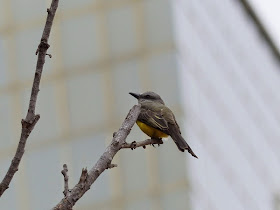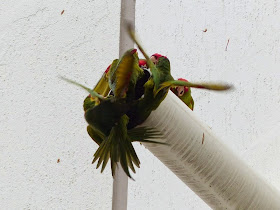A nasty early cold snap has hit Canberra, and we're thinking wistfully of the tropics. It's also been a wet cold snap, so I'm thinking most specifically of rain in the tropics, and it's only a few weeks since we were in the magnificent Kakadu National Park, in Arnhem Land in the 'Top End' of the Northern Territory. We got very wet there, but it was warm!
 |
Kakadu National Park is indicated by the red arrow, a little east of Darwin
(we live way down in the south-east corner of the continent).
The Tropic of Capricorn is marked, running pretty much across the middle of the map. |
January is definitely not tourist season in the Top End; while it's not especially hot - daytime maximum temperatures temperatures rarely vary beyond 32 to 34 degrees centigrade - humidity is usually close to 100% and it's standard for afternoon storms to roll in. But for a naturalist it's rich, the storms are magnificent, and of course there aren't many tourists...
Kakadu is one of the world's great parks, and at 20,000 square kilometres it's the largest national park in Australia (though some reserves in other categories are larger). Its significance has been recognised in its World Heritage Listing; it is one of only four places in Australia listed both for outstanding cultural and natural values. The Bininj Mungguy people and their ancestors have lived here for at least 50,000 years, making them the oldest living culture in the world.
 |
Burrunggui (more generally known, though incorrectly, as Nourlangie Rock) in woodlands, Kakadu NP.
This site was and is of huge importance to Bininj Mungguy people and contains many significant art sites. |
Habitats include vast savannah woodlands, monsoon forest, sandstone escarpment country, coastal habitats and rivers and associated wetlands. Kakadu supports a quarter of Australia's land mammal species and freshwater fish species and more than a third of its bird species.
 |
Chestnut-quilled Rock-Pigeon Petrophassa rufipennis Burrunggui.
This beautiful sandstone specialist is pretty much restricted to Kakadu. |
However a focus for us, in a too-brief visit, was the Cooinda (or Yellow Waters) Billabongs wetland complex, famous for its guided boat tours run by traditional owners (or often by biologist guides trained by them). We actually went out twice ('second time half price' or something, but we didn't need much persuasion), in the early morning and late afternoon.
This was Gudjewg, the Monsoon Season, which roughly corresponds to January - March. (The Bininj Mungguy traditionally recognise six seasons, based on what nature is doing, and these have been pretty much adopted by whitefellas there too, where European-based concepts of seasons don't mean much!) From our point of view the upside of this was that the boats could leave the river channels and travel across the flood plains; the downside is that with water across the whole vast landscape, birds have scattered with it, and perhaps counter-intuitively the Wet isn't a great time for seeing waterbirds. (Much better near the end of the dry when they are concentrating on diminishing waterholes.)
However we can and will come back for the birds; the experience of gliding through flooded channels and over the plains was mesmerising (though it's not easy to tell where one stops and the other starts). Perhaps the pictures can tell their stories for a while now.
 |
| Home Billabong at dawn. |
 |
| Channel, Cooinda. |
 |
| Yellow Waters Billabong, where the channel opens out. |
 |
| Yellow Waters Billabong. |
 |
Floodplain reflections, above and below;
in the photo above can be seen some infrastructure associated with a walking track used in The Dry. |
While birds, and even crocodiles, which tend to lie under the overhanging vegetation when the water's high, aren't very evident, there are still interesting plants to enjoy - as well there might be, with over 2000 species known from the park.
 |
| River Pandanus Pandanus aquaticus, a species always found along streamlines. |
 |
| Paperbarks Melaleuca spp., growing on the flood plain. |
 |
Water Lily Nymphaea violacea, found across northern Australia and in New Guinea.
This is a very important plant to local people, who eat roots, stems and seed heads, either raw or cooked. |
 |
Lotus Lily Nelumbo nucifera; also an important plant, for food and medicine, to the Bininj Mungguy.
Unlike the Water Lily however, this one is also found throughout much of Asia. |
 |
| Native Bamboo Bambusa arnhemica; a Top End endemic and one of only three bamboos native to Australia. |
 |
Livistona benthamii, a palm found in the Top End, Queensland and New Guinea,
where it is always associated with waterways and flooding. |
 |
Freshwater Mangrove Barringtonia acutangula Family Lecythidaceae.
Found in seasonally flooded wetlands across northern Australia and into Asia. |
Previous comments notwithstanding, there are always some birds to be seen.
 |
The world's eight jacana species are always a delight;
the Comb-crested Jacana Irediparra gallinacea is Austalia's only species,
though it is also found in Indonesia and the Philippines. |
 |
Here is a view of the remarkably extended toes which are the key feature of the group
and which enable to them to famously walk on lily pads. |
 |
| Eastern Great Egret Ardea modesta, in full magnificent breeding flush. |
 |
The sky was criss-crossed with skeins of Glossy Ibis Plegadis falcinellus (above and below)
more than I'd ever seen before in one place. I have no idea where they were going to or from though. |
 |
White-bellied Sea Eagle Haliaeetus leucogaster, found from India to Australia.
Always magnificent, this one was set off beautifully by the darkening storm clouds behind it. |
 |
By now, with sheet lightning blazing and thunder rumbling ever more loudly, it was
time to head for home; a small metal boat on water isn't the best place in such conditions. |
 |
Immediately after this photo was taken, it was definitely time to pack the camera away;
the boat had a canopy but the now torrential rain was coming in at 45 degrees.
Until then the front seats had seemed a very good place to be... |
It was a great excursion nonetheless, and we'll remember it with both fondness and awe.
Tropics in the Wet? Yes please!
(For a later post on Kakadu in the dry, see here .)
BACK ON WEDNESDAY





























%2BGawler%2BR%2BNP%2B0907.jpg)


%2BLEI%2B1105.jpg)
































